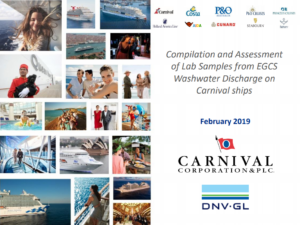The Clean Shipping Alliance 2020 held its first technical conference and presented a detailed study of the composition and quality of exhaust gas cleaning system (scrubber) washwater. The Carnival-led study, which lasted three years, gathered 281 wash water samples from 53 ships with scrubbers. This data was then assessed against 54 different test parameters by ISO accredited independent laboratories.
Then results were compared to selected national and International water quality standards and land-based wastewater discharge limits, including the German Waste Water Ordinance, the EU Industrial Emissions Directive 2010/75/EU, and the EU Surface Water Standards Directive 2013/39/EU.
[smlsubform prepend=”GET THE SAFETY4SEA IN YOUR INBOX!” showname=false emailtxt=”” emailholder=”Enter your email address” showsubmit=true submittxt=”Submit” jsthanks=false thankyou=”Thank you for subscribing to our mailing list”]
The study showed that the EGCS results compared favourably with all of these standards. Namely, the studied wash-water parameter concentrations were below the emission limits for land-based industrial point source waste water standards. CSA 2020 commented on this that:
This is not evidence of compliance with these standards (which are intended for a different regime and include other controls and limits for compliance than quality criteria). The comparison does however establish a point of reference to understand the quality of EGCS wash-water relative to other industrial discharges
In addition, very low and negative net post-EGCS values for certain wash-water parameters present a minimal contribution to the concentration of these parameters from the EGCS process (Arsenic, Cadmium, Lead, Mercury, Selenium, Thallium).
Moreover, the wash-water parameter concentrations also compared favourably to stricter water quality standards such as the EU surface water standards for inland waters. CSA 2020 once again noted that these standards have very different application and this comparison is not a definitive assessment of point source washwater quality. Nonetheless, they do provide a quantitative reference to understand wash-water parameter concentrations, especially for PAH compounds where there is absence of more suitable standards.
Furthermore, the average net Post-EGCS concentrations were calculated for ease of comparison. This means that values may not be representative of an individual vessel, considering the variance of the samples, and various operational conditions of each vessel.
Providing his comment on the results of the study, Ian Adams, Executive Director, CSA 2020, stated:
We want to emphasise that this major study was intended to provide an objective assessment of the quality of scrubber wash water through a rigorous comparison to other world water quality standards, and it now represents the largest, most credible and verifiable data set available. And importantly, the results reaffirm that exhaust gas cleaning systems are effective and safe for the ocean environment



































































And what about the Nitrates ?. That study does not mention it.
How would the Scrubbers work after the first year of use on board? We must take into account the corrosion of the components of the Scrubbers due to the presence of vanadium in the fuel that is a catalyst to activate the reaction that produces sulfuric acid.
Everyone knows that nitrates favor the growth of invasive algae that have, for example, invaded the seabed in the Mediterranean and especially in inland waters with little current.
All this is no more than a trick to avoid Buqueques using fuels of less than 0.50% mass sulfur.
And what happens with NOx, also eliminated by Scrubbers?